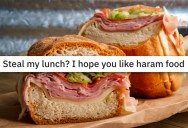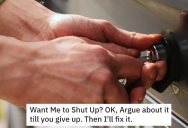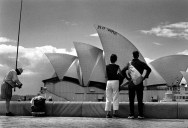Billboard Bandits: An Intimate Portrayal of Culture Jamming
by twistedsifter
In the 1970s and 80s a group of protestors calling themselves BUGAUP scrawled anti-tobacco messages on billboards across the country, leading to an Australia-wide ban on tobacco advertising and making the group world pioneers of a movement now known as culture jamming.
Culture Jammers, a new photographic exhibition at the Museum of Sydney which opened in February, features for the first time the work of award-winning photojournalist Dean Sewell as he followed a small group of Sydney culture jammers, documenting their activities between 2003 and 2007.
Deriving from ‘radio jamming’, a type of censorship used by totalitarian regimes to block foreign broadcasts, culture jamming is a form of political and social activism that involves subversively altering mainstream advertising messages to cast a critical spotlight on governments, corporations or individuals, and question commercial culture.
Motivated by a range of social issues, from environmental causes to the war in Iraq, Sewell followed a group of activists known as The Lonely Station, as they altered billboards and posted messages across Sydney, allowing their creative processes, daring acts and outcomes of their interventions to be captured on camera.
“No War” – March 2003, Opera House & White Bay
On the eve of the invasion of Iraq, Will Saunders and Dave Burgess boldly scaled the Sydney Opera House to paint an anti-war message in bright red across the top of its highest sail. Authorities’ initial efforts to stop the paint drying before it could be removed involved applying a specially formulated jelly, but this made the paint streak down like dripping blood.
Within hours the message was gone. But it had already made headlines around the world, embarrassing the Australian Government at a time when security was supposed to be tight due to the heightened fear of terrorism.
This high-profile action was noted by activist group The Lonely Station. In a show of support for Saunders and Burgess, who had been sentenced to nine months periodic detention and fined $151,000 for ‘malicious damage’, The Lonely Station started inscribing the words ‘no war’ wherever they saw an image of the Opera House. They painted the slogan on a billboard at White Bay every Friday night for three weeks. It was cleaned off each time.
“So Baghdad” – December 2003, White Bay
Just before Christmas in the first year of the Iraq War, The Lonely Station decided to attach an antiwar message to this extremely large billboard atop the silos in White Bay. A Santa hat and a machine gun were added to the scantily clad model’s attire, with a festive ‘ho ho ho’ under the culture jammers’ newly fashioned helicopter logo and slogan, ‘democracy we deliver’.
‘Ned made the helicopter stencil from a photograph in John Howard’s terror manual that we got in the post. We didn’t know at the time, but the original image came from a photo taken by Dean [Sewell]. Later, when Dean saw the finished product, he was quite happy that his piece of military propaganda wasn’t totally wasted.
‘Ned was a talented young artist. Unlike most art students, he could draw. In his shed in Bronte were a couple of canvases hanging that he had painted. I was looking at them one day and asked him what his favourite medium to paint on was. I felt like a bit of a loser when he deadpanned, “walls”.’ – Neal Funnell, 2011
“Woodchipping the Spirit of Tasmania” – January 2004, Sydney Harbour
‘I was with a friend in a pub in Hobart in July 2003when a story about the upcoming new boat came on the news. We were a bit drunk but managed to grasp the potential significance of it. The next day I bought four tickets on the maiden voyage leaving Sydney in January.’ – Neal Funnell, 2011
The launch of the passenger ferry Spirit of Tasmania III was a lavish affair with the event’s organisers hoping to attract extensive media coverage. However, the type of coverage that ensued was not quite what the Tasmanian Government had hoped for. The Lonely Station’s carefully planned and meticulously executed action conveyed a powerful environmental message about the destruction of Tasmania’s forests.
Members of The Lonely Station boarded the vessel after claiming to be sailors and bluffed their way through a security check. They carried a pre-prepared canvas banner inside a sail bag, and wore abseiling gear under their spray jackets. As dignitaries drank champagne on the upper deck, the activists abseiled down the side of the vessel to hang their banner. Dean Sewell, who had been tipped off in advance, quietly hopped into a water taxi and sped away to the best vantage point to capture these images.
“Helping You Communicate Better?” – June 2004, Sydney Airport
‘The torture and abuse of detainees in Iraq by the US Army was a really big story at the time. We got the Abu Ghraib image from the [Sydney Morning] Herald archives, copied it onto a transparency, projected that onto a wall and traced the outline. When we put it on the ground I accidently spilt a tin of paint over the image. Raven, who fancied himself as a painter and took himself quite seriously, suggested we do the whole thing Jackson Pollock style. It took all day and we felt very clever at the end.
The image is over 8 metres [high], which gives an idea of the scale of the billboard. ‘We turned up at the airport just before 6 o’clock in the morning. We thought peak hour would be a safe time because passing motorists would never believe we would be stupid enough to do something “illegal” in front of so many people. Also, I had a uni exam that afternoon and needed to get home and study.’ – Neal Funnell, 2011
The bottom of the structure was about 5 metres off the ground. In order to climb up, the activists threw a rope up and over the scaffold then attached a rope ladder. Standing atop the billboard, they lowered down the new image and affixed it with staple guns.
“I Vote” – September 2004, Darlinghurst
In 2004 the Liberal-National Australian Government proposed electoral reform that would deny prisoners sentenced to longer than three years in jail the right to vote in federal elections. The punchline of this billboard, referring to the proposed changes, was in fact a ‘blooper’. Confusion arose because in New South Wales, prisoners jailed for more than 12 months were already banned from voting in state elections.
‘We got the timing right – the [Sydney Morning] Herald ran a really large photo of this on their back page a day or two before the 2004 election. But true to form, we f#cked up the important part … I was having a chat with a professor at uni when I asked him if he’d seen the paper [that day]. He shook his head incredulously and pointed out that new federal legislation precluded prisoners serving sentences of three years or more from voting – not 12 months. I didn’t tell him we were responsible.’ – Neal Funnell, 2011
“65% Old Growth” – c2003, Woolloomooloo
‘A large proportion of the paper Reflex was producing was sourced from old-growth forest in north-eastern Victoria. Their advertising was disingenuous and classic greenwashing.
‘We had a friend who was a graphic designer. We would email her a picture of the ad we were interested in and what we wanted done, and she would send back the new text in matching font … The next step was projecting [the picture] onto a wall and tracing the image. We didn’t have a projector so we normally used one of the projectors in the classrooms … at [the University of New South Wales] after classes were finished. Later, as our images got
bigger, we were able to use a warehouse that had big walls.
‘You can get onto the [train] tracks near the entrance to the tunnel at Kings Cross … From the tracks you can look down into all the shady late night goings-on in Woolloomooloo. This was the only billboard of interest we ever saw at this location, which was a shame because it was such a good spot to hang out.’ – Neal Funnell, 2011
“Which Bank?” – c2004, White Bay Power Station
‘In 2004 the Commonwealth Bank was the largest investor in the Tasmanian logging company Gunns Ltd. A large part of the [environmental] campaign against Gunns Ltd was based in Sydney where most of their big corporate investors were located. This was part of that campaign.
‘To stop people climbing up, the ladder up the chimneystack started about 10 metres off the ground. Scotty attached a rope to the bottom rung and two guys climbed up using ascenders. It was very windy and, higher up, flakes of rusted metal were peeling off.
‘One of the guys froze around the “E” on “TRASHES” and couldn’t go any higher. Scotty then had to paint the whole thing by himself. He had his mobile phone and he had to keep calling us to check the spelling. The writing stayed there for about three weeks. You can still see where a crane was used to paint over it.’ – Neal Funnell, 2011
“Preventative Detention” – September 2005, George St. Sydney
In the wake of various terrorist attacks overseas, the then Prime Minister John Howard’s Liberal-National Government proposed, and eventually passed, new anti-terrorism laws. Federal police were given the power to detain or control the movements of people suspected of future wrongdoing. The bill was controversial. Many Australians considered its preventive detention provisions an infringement of civil liberties.
‘This image of [John] Howard comes from a Bill Leak cartoon with some minor modifications: we put him in a school uniform. Originally we wanted to stencil the writing and blackboard onto a wall in Darlinghurst and stick the image over the top of it, but were stopped by council rangers.
‘This version was done on the morning of the Sydney Swans’ tickertape parade down George Street in the city. We were hoping it would be caught on film as [the Swans] went past it. Unfortunately it was pulled down just before the parade started.’ – Neal Funnell, 2011
“A New Empire” – October 2003, Sydney Airport
‘Apart from making aeroplanes for Qantas, Boeing is the third largest defence contractor in the world. We didn’t really know what that meant, but it didn’t sound very nice. We changed this billboard on the morning that [then American President George Bush] flew into Sydney. The location of the billboard opposite the airport was good because there was a fair chance Bush’s cavalcade would go past it.
‘A couple of years earlier, Dean [Sewell] had written in very large and messy spray paint, “BSUH” on the bottom half of a “FCUK” billboard in the Cross. I liked the schoolboy naughtiness of it, and loved the amateur cartoon-like explosions that Ned painted.
‘Really, this was designed as a welcoming banner for Bush. The American flag was only added upside down because we were worried the rest of our additions might be lost on him, or even worse, confused with the original image and viewed positively.’ – Neal Funnell, 2011
Museum of Sydney Curator Inara Walden says, “Some people consider culture jamming to be illegal graffiti, while others consider it to be a legitimate form of social commentary or protest, even calling it political art. The activists see what they are doing as a way to question commercial culture and consumer manipulation by corporations.”
The exhibition features over 40 of Sewell’s photographs as well as a short film highlighting the intricate processes behind each campaign, from photographing, to the making of each artwork on the ground, before climbing to affix giant banners and graphics at height.
Culture Jammers: Dean Sewell 11 February – 11 June 2012 at the Museum of Sydney, corner Bridge & Phillip Streets Sydney, General $10, Concession $5, Family $20, More Info hht.net.au or 02 9251 5988.
If you enjoyed this post, the Sifter highly recommends:
Trending on TwistedSifter





